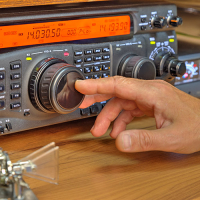Witness to history: World War II vet reflects on conflict, atomic bomb

Turning onto Qualla Road in Waynesville, the meandering route goes from pavement to gravel to dirt within a half-mile. By the time you realize it has been a little while since you’ve seen a mailbox, a small cabin appears in the tree line to the left.
Pulling into the driveway, an older model Dodge Neon sits atop it with a “World War II Veteran” plate attached to the back bumper. Knocking on the front door, a voice echoes from inside. “Sounds like we have some company,” Robert Bridgman said, swinging open the door, extending a shaky, welcoming hand, a “World War II Veteran” hat hanging off his head.
“When you’re 17 years old, war is exciting, to be in it and to fight for your country,” the 92-year-old said. “But, we lost a lot of men in World War II, and I knew many people who didn’t come back.”
Born in Cotter, Arkansas, in 1924, Bridgman was the son of a railroad worker, bouncing around the South throughout the Great Depression, with stops in Kentucky, Chattanooga and eventually Charleston, South Carolina. And it was on Dec. 7, 1941 when a 17-year-old Bridgman was exiting a movie theater when he heard the fateful news.
“I came outside and somebody said the U.S. base in Pearl Harbor had been bombed by the Japanese,” he said. “And it didn’t ring a bell with me at all. I didn’t know where Pearl Harbor was.”
Once Bridgman realized the seriousness of the attack on the military installation in Honolulu, Hawaii, and the United States entrance into World War II, he also got the thought in his head that he wanted to sign up and serve his country.
Related Items
“But, my father, who had been in World War I, he didn’t like the idea of me jumping into the war,” Bridgman said. “So, he sent me to Pearl Harbor a little while after the attacks, to work in the Navy yard as a laborer.”
When Bridgman reached the crippled Hawaiian base, the property was in disarray, with sunken battleships still sitting in Pearl Harbor, the damage still vivid from Dec. 7.
“Pearl Harbor was terrible,” Bridgman recalled. “Everything was just bombed out. You had the USS Arizona at the bottom of the harbor (where it still resides) and the USS Oklahoma upside down, both with dead soldiers still in the hulls.”
Bridgman remembers standing on the dock in Pearl Harbor and watching the USS Oklahoma get righted in 1943. But, following years of salvaging and stripping of her parts, the ship eventually sank in a storm as it was being towed to San Francisco in 1947.
While working in the Navy yard, Bridgman was there first-hand when the “West Loch Disaster” occurred. On May 21, 1944, U.S soldiers were loading massive amounts of ammunition and fuel into ships headed to Saipan when an explosion rang out. The enormous fireball killed 160 and wounded 400, destroyed 20 building and nine ships.
“There were body parts everywhere, everywhere,” Bridgman winced.
And on Oct. 21, 1944, Bridgman, now 20 years old, signed up to join the Navy.
“I got the wild idea to be in the Navy,” he said. “I thought they’d send me back to the States for boot camp and maybe I’d be home in six weeks. But, they didn’t even cut my hair before I was assigned to the USS San Marcos.”
A landing ship dock, Bridgman wandered around the Pacific on the vessel as World War II came to a close. And while others finally went home, Bridgman remained in the Navy, eventually finding himself at the Bikini Atoll in July 1946 — test site for several atomic bomb explosions.
Bridgman stood there on his ship, mere miles from “ground zero” of the detonation, with the bull’s eye target being the USS Nevada (another victim of the Pearl Harbor attacks), which was painted bright red to distinguish it from the dozens of other battleships and vessels surrounding the test site.
“The first atomic bomb missed its target (USS Nevada), so they detonated another one, and there she was — the Nevada — still standing there,” Bridgman said. “It was as if the whole sky caught fire. It was terrifying. Not a lot of us still around that witnessed those bombs.”
Well, wasn’t that because a lot of those there at those test sites got cancer and passed away?
“Yeah, and it’s funny, though, because the Navy never told us about how dangerous the radiation was,” Bridgman said. “You just do your job and hope you get out safely.”
Following his discharge from the Navy, Bridgman ended up studying civil engineering at Western Carolina University in Cullowhee. From there, he taught at vocational schools in Canton and Asheville for decades. These days, Bridgman, a widower who was married for 61 years, sits in his cabin with his cat, often coming “into town” to run some errands. It’s a quiet life, but a good life in his eyes, as he smiles when thinking back on the long and bountiful road that is his journey.
“Seems like every time a war comes along, Uncle Sam tries to get in it,” Bridgman said. “But, with World War II, we had to get involved. I got lucky, though — I was able to come home.”













